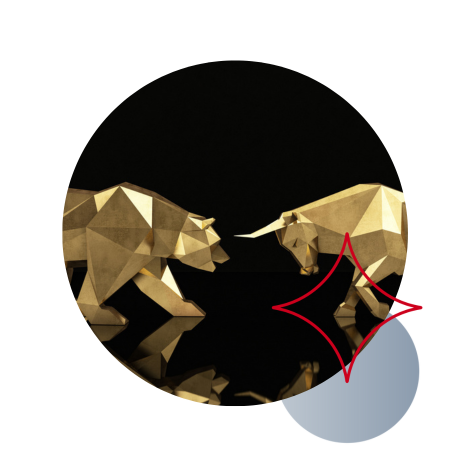Bullish, Bearish, Dovish, and Hawkish
Get exclusive market updates and the latest currency exchange news sent straight to your inbox

What’s the animal kingdom got to do with finance?
4 minute readBullish vs. bearish
Bullish and bearish describe what an investor or analyst thinks about financial market conditions. They are opposite terms that define whether someone thinks the price of an asset will appreciate or depreciate.
A bullish investor thinks that the price of an asset will rise, whereas a bearish investor thinks that it will fall.
Bullish and bearish are also used to describe the difference between previous market conditions and whether they were appreciating or depreciating in value. For example, when we speak about the 2008 financial crisis, it’s usually described as a bearish market.
The terms are believed to have derived from how the animals fight - bulls thrust their horns in the air, while bears jab downwards with their paws.
What is a bull market?
Similarly, a bull market exists when prices are rising or expected to rise continuously. Although the term is usually used to describe the stock market, it can actually be applied much more widely - bonds, real estate, currency, and commodity trading can all experience bull markets.
Markets tend to fluctuate constantly, so using the term ‘bull market’ is reserved by traders for when there has been an extended period of price rises after a period of recent lows.
Optimism, investor confidence, and positive expectations all characterise a bull market. These psychological effects and speculation can make trends difficult to predict. Although some factors tend to exist at the same time, these include:
- Economic growth
- Strong GDP
- Decreasing unemployment
- Increasing corporate profits
- Increasing investor confidence
What is a bear market?
A bear market is the opposite of a bull market when prices experience a downward trajectory. A pessimistic outlook tends to accompany a bear market.
The opposite conditions tend to accompany a bearish market, including:
- A weakening or weak economy
- Weakening GDP
- Increasing unemployment
- Decreasing corporate profits
- Decreasing investor confidence
Dovish vs. Hawkish
Where bullish and bearish describe opposites in the financial markets, dovish and hawkish describe opposing positions in monetary policy – particularly regarding interest rates. We often hear about hawkish and dovish tendencies concerning central banks.
Central banks use interest rates to try and control inflation. An inflation dove describes an economic policy advisor who prefers monetary policy that involves low-interest rates and quantitative easing, believing that it will stimulate economic growth and reduce unemployment. On the other hand, an inflation hawk believes in using high-interest rates to tackle inflation.
Another way of looking at it is that doves support expansionary monetary policy, whereas hawks favour a tightening in economic policy.
Inflation hawks are named after the bird of prey because they tend to be associated with a more aggressive monetary policy. Doves are seen by investors as more placid and conservative and the opposite of a hawk.
What happens when central banks favour hawkish policies?
Higher interest rates brought about by hawkish policies do have their advantages. It can make people less likely to borrow money and more likely to save, reducing consumer spending, which should have an impact on controlling inflation.
But when interest rates become too high, they can cause a decrease in prices and deflation. Deflation is considered worse for an economy that moderates inflation because when prices begin to fall, people expect the trend to continue. The result is that people will put off spending today because they would instead buy at a lower price tomorrow, reducing demand and slowing economic growth.
And dovish policies?
Dovish monetary policy tends to push the market up. Low-interest rates mean money is cheap to borrow and unprofitable to save, so people will spend more, boosting demand for goods and services and reducing unemployment. With so much money in the market, more people will invest in stocks and shares, making companies more profitable and increasing economic growth.
Critics argue this will eventually lead to rising prices, runaway inflation, and an overheated economy.


